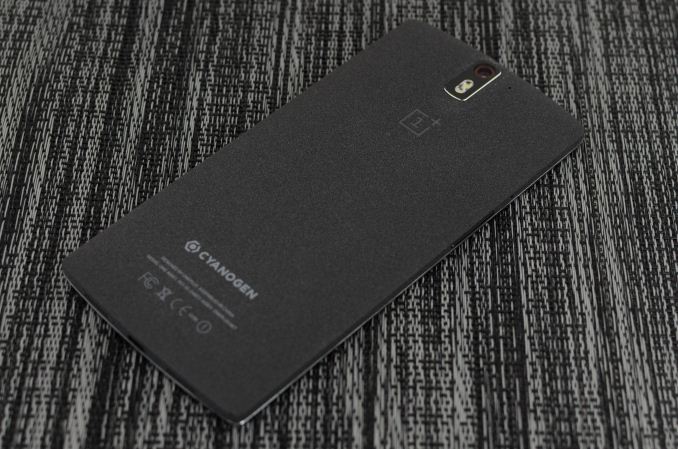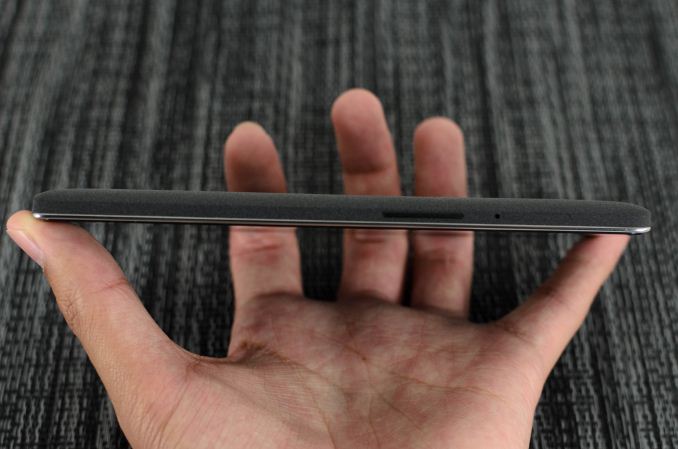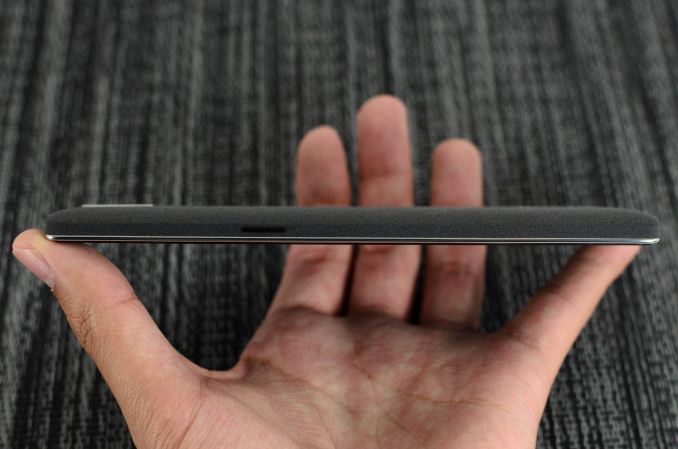The OnePlus One Review
by Joshua Ho on November 19, 2014 8:00 AM EST- Posted in
- Smartphones
- Android
- Mobile
- OnePlus

The OnePlus One has been one of the most hyped smartphones of 2014. There's really not much else to be said, as OnePlus' marketing has been quite noticeable amongst Android enthusiasts. The OnePlus One seems to come from nowhere, although there is a noticeable resemblance to the Oppo Find 7A which is produced in the same factory. The OnePlus One is said to be a flagship killer, as its high-end specs come with a mid-range price. The 16GB version starts at 299 USD and the 64GB version starts at 349 USD. With a 5.5" 1080p display, Snapdragon 801 SoC, and plenty of other bits and pieces to go around, the specs are certainly enough to make it into a flagship phone. Of course, the real question is whether it really is. After all, while specs provide the foundation, what makes a phone bad, good, or great has to do with the entire phone, not just the spec sheet. At any rate, I've attached this spec sheet below to give an idea of what to expect from the phone.
| Oppo Find 7a | OnePlus One | |
| SoC | MSM8974ABv3 2.3 GHz Snapdragon 801 |
MSM8974ACv3 2.45 GHz Snapdragon 801 |
| RAM/NAND | 2 GB LPDDR3, 16GB NAND + microSD | 3GB LPDDR3, 16/64GB NAND |
| Display | 5.5” 1080p IPS LCD (JDI) | 5.5” 1080p IPS LCD (JDI) |
| Network | 2G / 3G / 4G LTE (Qualcomm MDM9x25 UE Category 4 LTE) | 2G / 3G / 4G LTE (Qualcomm MDM9x25 UE Category 4 LTE) |
| Dimensions | 152.6 x 75 x 9.2 mm, 170 grams | 152.9 x 75.9 x 8.9 mm, 162 grams |
| Camera | 13MP (4128 x 3096) Rear Facing, 1/3.06" CMOS size (Sony IMX214), F/2.0, 5MP FFC w/ F/2.0 aperture | 13MP (4128 x 3096) Rear Facing, 1/3.06" CMOS size (Sony IMX214), F/2.0, 5MP FFC w/ F/2.0 aperture |
| Battery | 2800 mAh (10.64 Whr) | 3100 mAh (11.78 Whr) |
| OS | Android 4.3 with ColorOS | Android 4.4.4 with CyanogenMod 11S |
| Connectivity | 802.11a/b/g/n/ac + BT 4.0, USB2.0, GPS/GNSS, DLNA, NFC | 802.11a/b/g/n/ac + BT 4.0, USB2.0, GPS/GNSS, DLNA, NFC |
| SIM Size | MicroSIM | MicroSIM |
Needless to say, the OnePlus One is a close cousin of the Find 7a, and its specs are top notch. There's a great foundation, so we'll move on with some initial hardware impressions.
Of course, the first part to look at is industrial and material design, along with any other immediate observations about the phone. From the front, the phone is almost a pure expanse of black glass. There are outlines for the capacitive keys, but these are quite faint most of the time. The contrast of the silver plastic ring only emphasizes this, and the lack of logos helps to make the design stand out by virtue of its minimalism. Picking it up, the feel of the sandstone black finish is incredibly unique and unlike anything I've ever felt. The finish has been described as soft sandpaper, and that's a description I'd agree with. It makes the phone feel much grippier than one might expect. The back cover is also strong, with no real give and no flex. Other than a few logos, the only significant design elements on the back are the camera, dual LED flash, and a hole for the microphone. The front of the phone has surprisingly great attention to detail as well. The silver plastic piece on the front of the phone makes the finger smoothly roll off of the display when swiping around, and the imperceptible feel of the earpiece helps to contribute to the sense that this is a single, well-built phone.
On the sides, the minimalistic theme continues. There's only a power button on the right side, a headphone jack and microphone port on the top, and a volume rocker on the left side. The SIM tray is also on the left side, and on the bottom of the phone we see two speakers, a USB port, and a microphone hole. In general, the feel of the power and volume buttons are great, with no slack and a clean, if subdued click upon activation.
Needless to say, OnePlus has done a fantastic job. However, there are a few issues to talk about. First, the size is definitely too much to handle. If the LG G3 was at the very edge between a phone and phablet, the OnePlus One firmly steps into phablet territory. At some point a line in the sand has to be drawn, and it only makes sense to do so here. The angular corners of the OnePlus One combined with its larger footprint makes for a phone that is almost impossible to comfortably use with one hand. I can't help but feel that this would've been a far more impressive phone if shrunk to a 5" display size, as in my experience it takes two hands to comfortably use this phone. The other issue is much more subtle though. For some reason or another, the glass lens covering the display of the phone feels as if it has noticeably higher friction than other phones I've used. It almost feels as if the oleophobic treatment of the glass is either missing or thinner than most. Of course, overall the phone is great from a basic design perspective. The size seems to be a matter of OnePlus' start-up position and the need to share parts with the Find 7a, although the feel of the glass is unlikely to be an issue for most.













148 Comments
View All Comments
Harry_Wild - Thursday, November 20, 2014 - link
I saw many interviews were Android App developers were ask what personal phone they are using responded shyly - "iPhone #*". So, that explains many things here!grayson_carr - Thursday, November 20, 2014 - link
I am an iOS developer and my current phone of choice is the Nexus 5.Conficio - Friday, November 21, 2014 - link
Care to link to at least three of these "interviews"coburn_c - Wednesday, November 19, 2014 - link
Why do your custom screen and battery tests never line up with gsmarena? Their screen results always have different white brightness levels then yours, and their battery tests are always more in line with synthetic scores than yours. They put the contrast of this things screen at 800:1 and the battery life below the G3.2kfire - Wednesday, November 19, 2014 - link
Re: battery, GSMArena uses 50% instead of a fixed luminance.Cinnabuns - Wednesday, November 19, 2014 - link
Just to add to what 2kfire pointed out, the author states:"200 nits on a phone can be as low as 50% and as high as 90%, so setting a standardized brightness percentage would not be an effective method of controlling for display brightness."
I would not trust GSMArena's battery tests as they do not understand how to perform a controlled test.
coburn_c - Thursday, November 20, 2014 - link
Their test was in-line with what the synthetic said here and in line with the common sense of less throttling and less software optimization don't make for more battery life.Master_Sigma - Wednesday, November 19, 2014 - link
Very pleased to see Anandtech coming around to reviewing this phone. While I disagree with the opinion that too many options are a negative, especially given the target audience for this device, I pretty much agree with the assessment of the hardware and software.FreakTM - Wednesday, November 19, 2014 - link
I think the opinion was more towards the fact that the options were causing some sacrifice on the user-friendliness of the experience, which I think is a fair opinion. Many options, good; many options presented in a confusing way, bad.mrex - Wednesday, November 26, 2014 - link
Better to have options than not having them. You dont need to use them if you dont want to, but if they dont exist at all, you could only dream about them... the phone is very user friendly, imo.